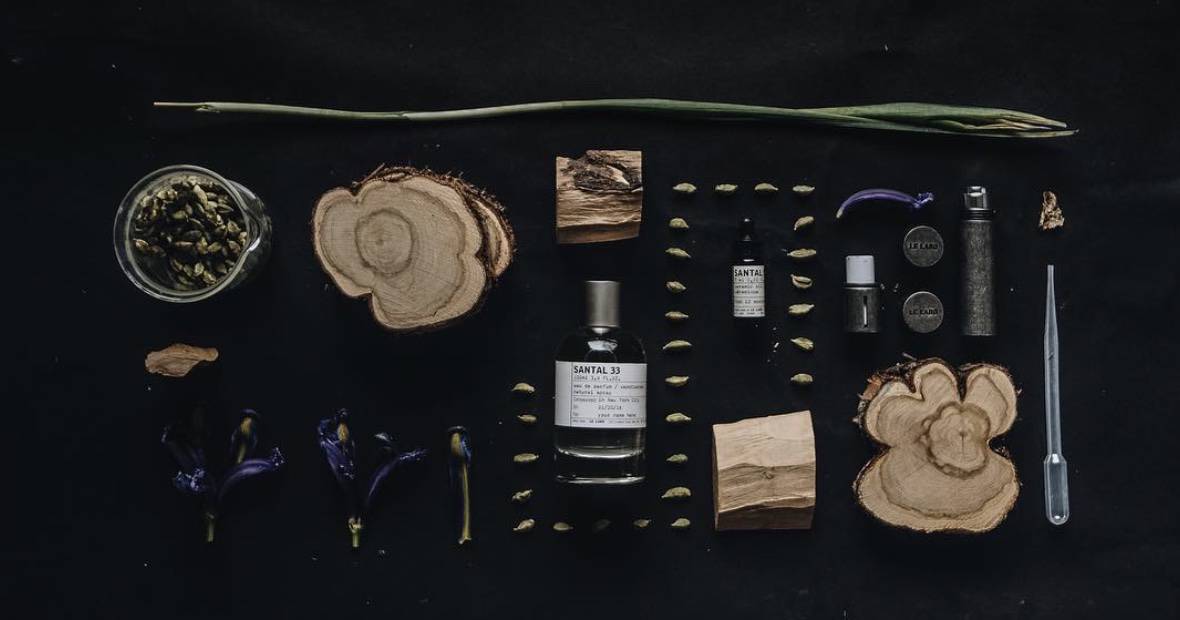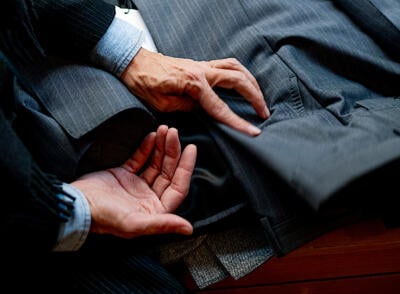If you’ve been thinking about getting an ear piercing, you’re not alone. A quick look around will show you that men’s ear piercings are everywhere, from regular joes to the hottest stars like Harry Styles and Michael B Jordan. And they’re often sporting more than one.
A solid decade ago, it was definitely more taboo to see your average guy in an earring. Thankfully, things have changed, and there’s a much more socially acceptable crossover between what is considered feminine and what is decidedly masculine. Plus, ear piercings express your unique style in a way naked ears simply can’t.
As for the position of your piercing, well, the options are endless. From the helix, conch, tragus, and classic lobe styles, you can incorporate earrings wherever you choose. But don’t just start adding holes in your ears. It’s important to understand where each position is located on the ear, the recovery process, and how to take care of it. No one likes infected piercings.
Keep scrolling and take a look at all of the different men’s ear piercings to decide for yourself.
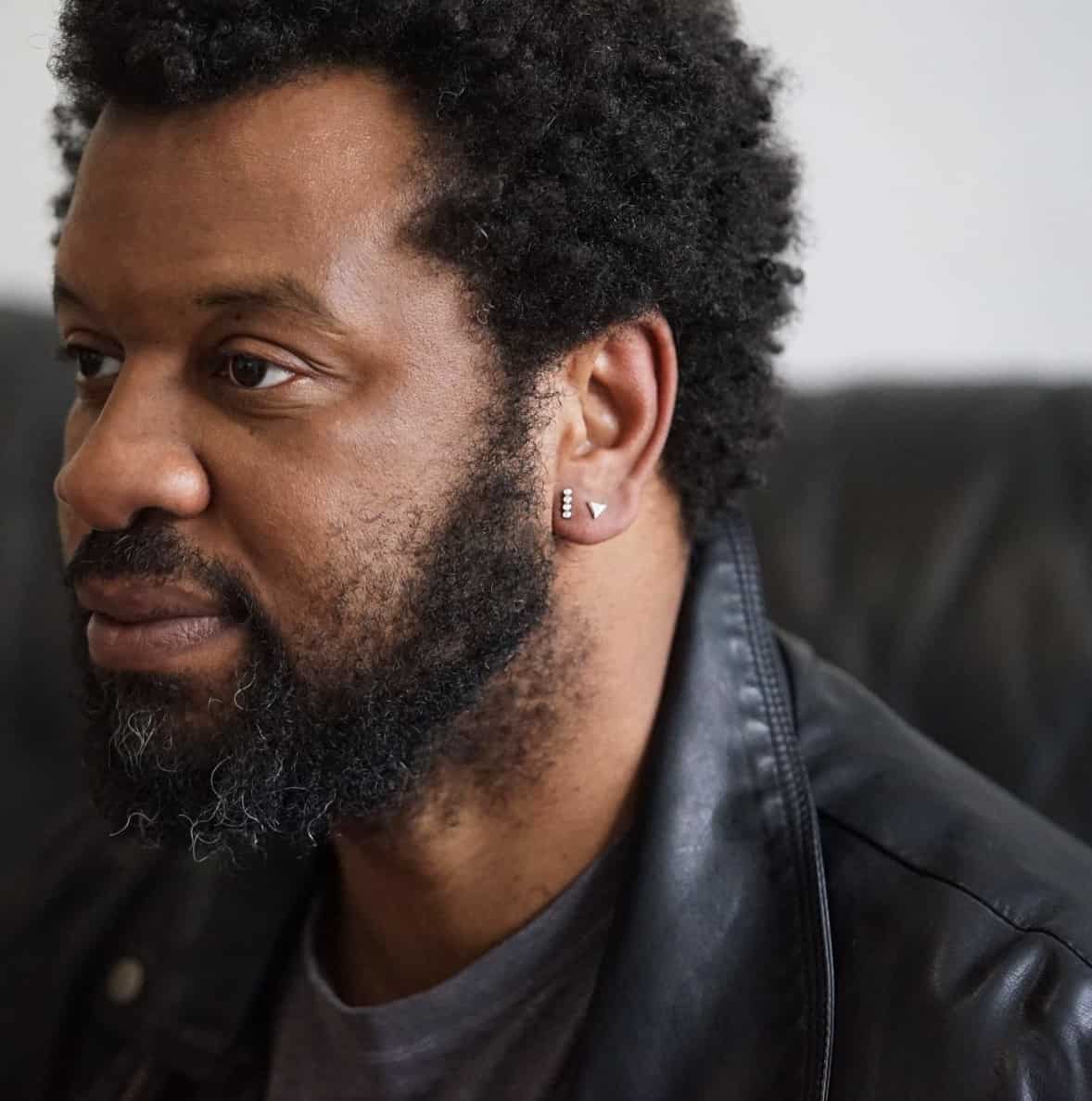
Just one earring in each ear? Why not two in the same ear? The lobe is the lowest, thickest part of the ear, with plenty of room for a double ear piercing style. Not only is it unexpected, it’s pretty fresh and bold. These men’s ear piercings are for the guy who wants to stand out but in a subtle way that’s probably still acceptable at the office.
Try two matching gold or silver hoops next to each other for a hot modern look. Because a double ear piercing occurs on the lobe, it’s a great way to try out multiple piercings in the least painful part of the ear. Plus, you’re working with only two to three months of healing time.

Choosing between the left or right ear may seem like a throwaway decision, but it may matter if you’re a side sleeper. If you prefer sleeping on your right side, then a left ear piercing is going to be way more comfortable during the healing process.
Fortunately, tons of brands offer single earring purchases like this solid gold stud with an ethically sourced diamond at its center.
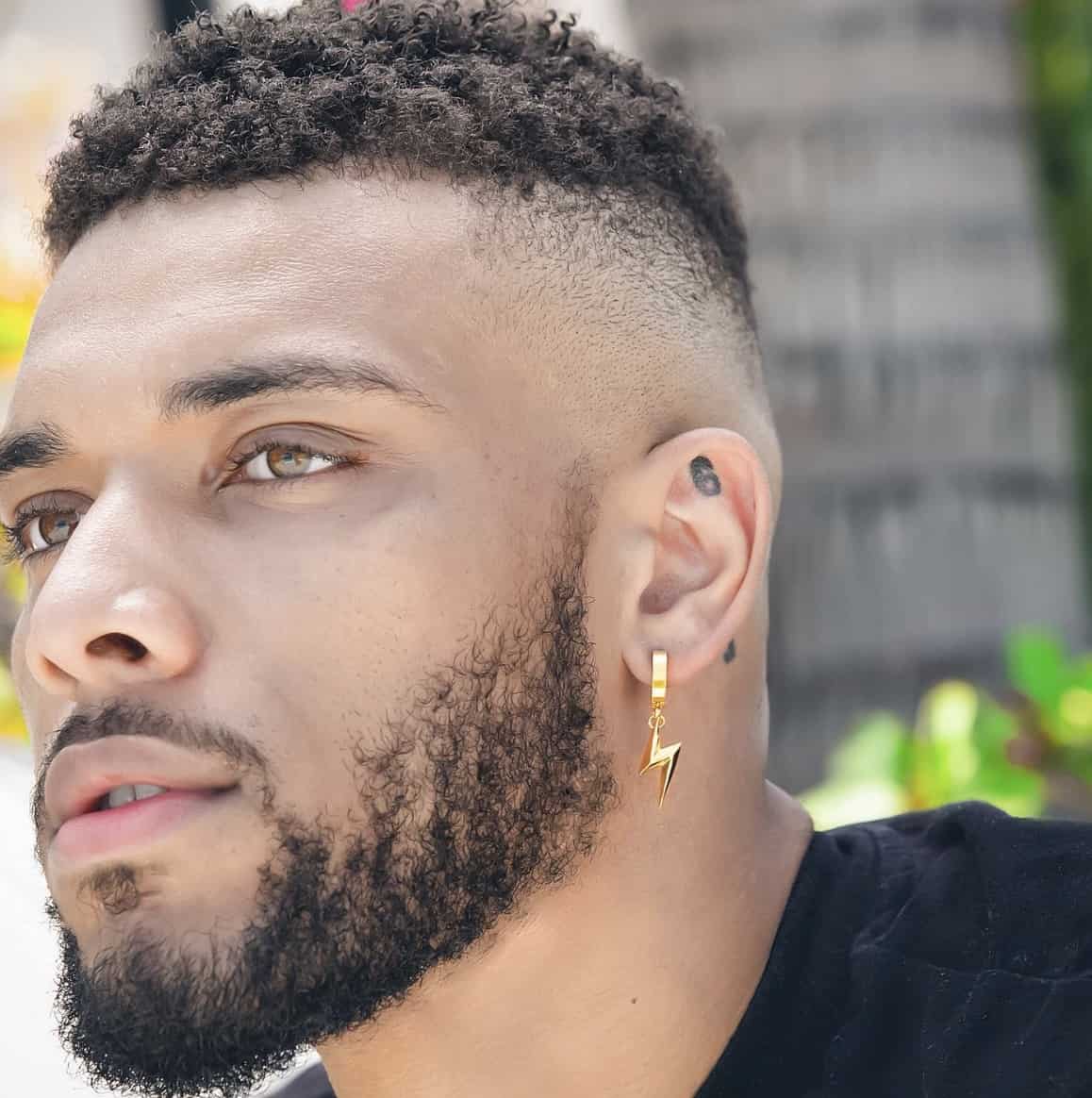
You may have heard about the ‘gay’ ear piercing worn on the right side back in the day. As LGBTQ acceptance has become much more mainstream, a right earring today is nothing more than a cool ear piercing for men. In fact, as far as straight culture goes, tons of women absolutely love men’s ear piercings, especially of the one-sided variety.
A single ear piercing looks pretty sleek, so why not try something a little more bold, like this screw-inspired silver hoop?

The most common ear piercing for men is on the lobe. Because this kind of piercing is more traditional, it’s great for the guy who’s new to ear piercings in general. Plus, we hate to say it, but it is the most socially acceptable piercing, so that’s something to keep in mind depending on the people in your life.
With proper care, it also heals the quickest of all piercings—within one to two months. Wear a simple stud or hoop for a clean look, or express your personal style with something a little edgier.

Much like men’s tattoos, helix piercings are also wildly trendy. This piercing is a hole located on the upper cartilage part of the ear, conveniently known as the helix. Next to the lobes, it’s probably the second-most popular spot for piercings.
Like the lobe, you’ve got some freedom in choosing an earring style. While a stud might be more comfortable for the initial piercing, we love a simple silver helix cuff. Keep in mind that, unlike a lobe piercing, the helix takes longer to heal, about three to six months.
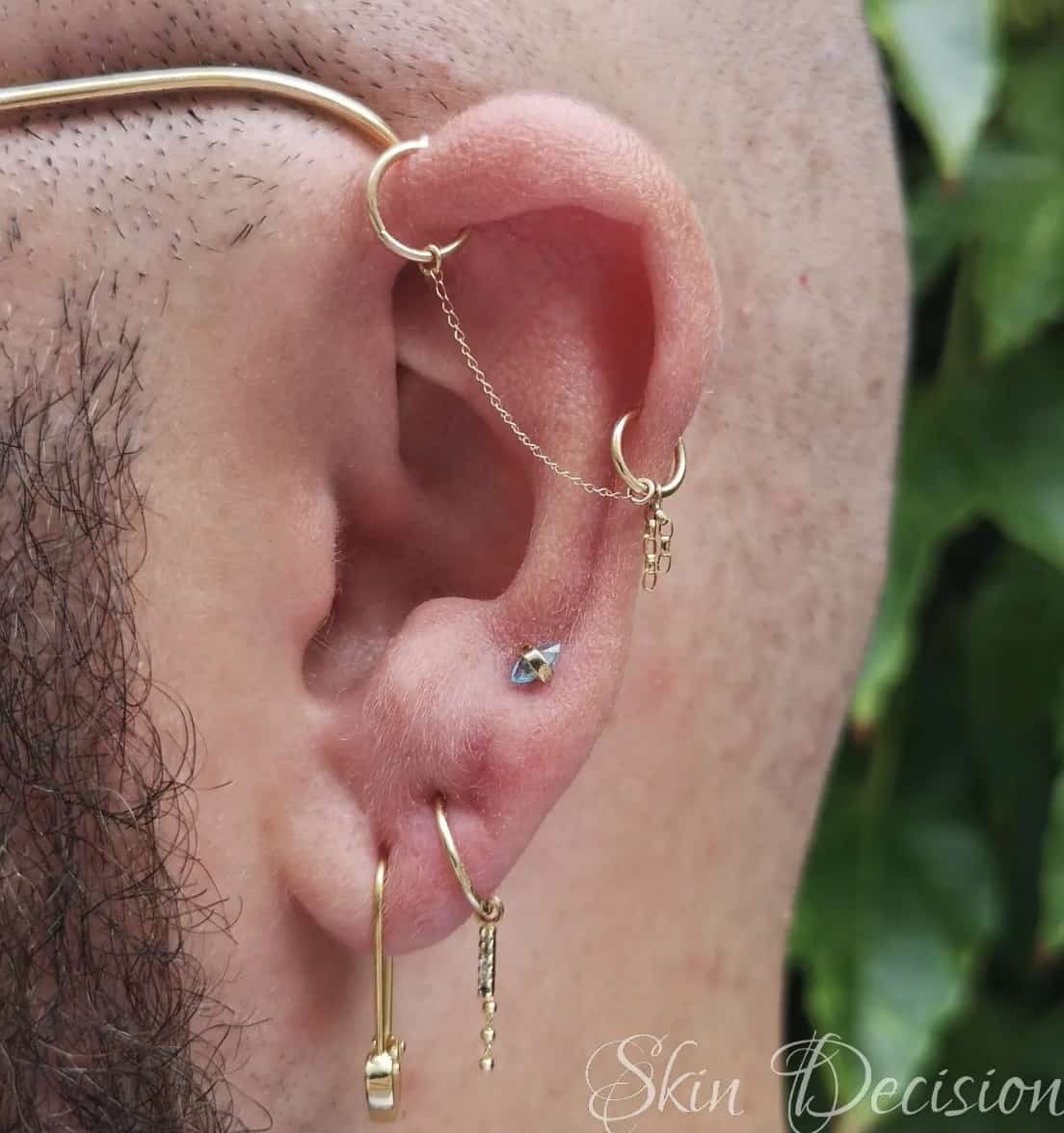
An auricle piercing is an outer ear hole on the rim of the cartilage located between the earlobe and the helix. Fine as a stand-alone piercing, it looks especially interesting when paired with a helix and lobe piercing.
As much as these men’s ear piercings are cool, they aren’t for the fair weather fellow. You’re looking at a six-to-eight-month healing window. It may be tempting to add a delicate hoop when you get pierced, but you should start with a stud. It’s going to be most comfortable and have the right thickness for the healing process.
Trust us, avoid choosing a cheaper earring. Instead, go for quality like solid gold, silver, or titanium. These tiny black diamond studs are perfect, plus they’re sold as singles.
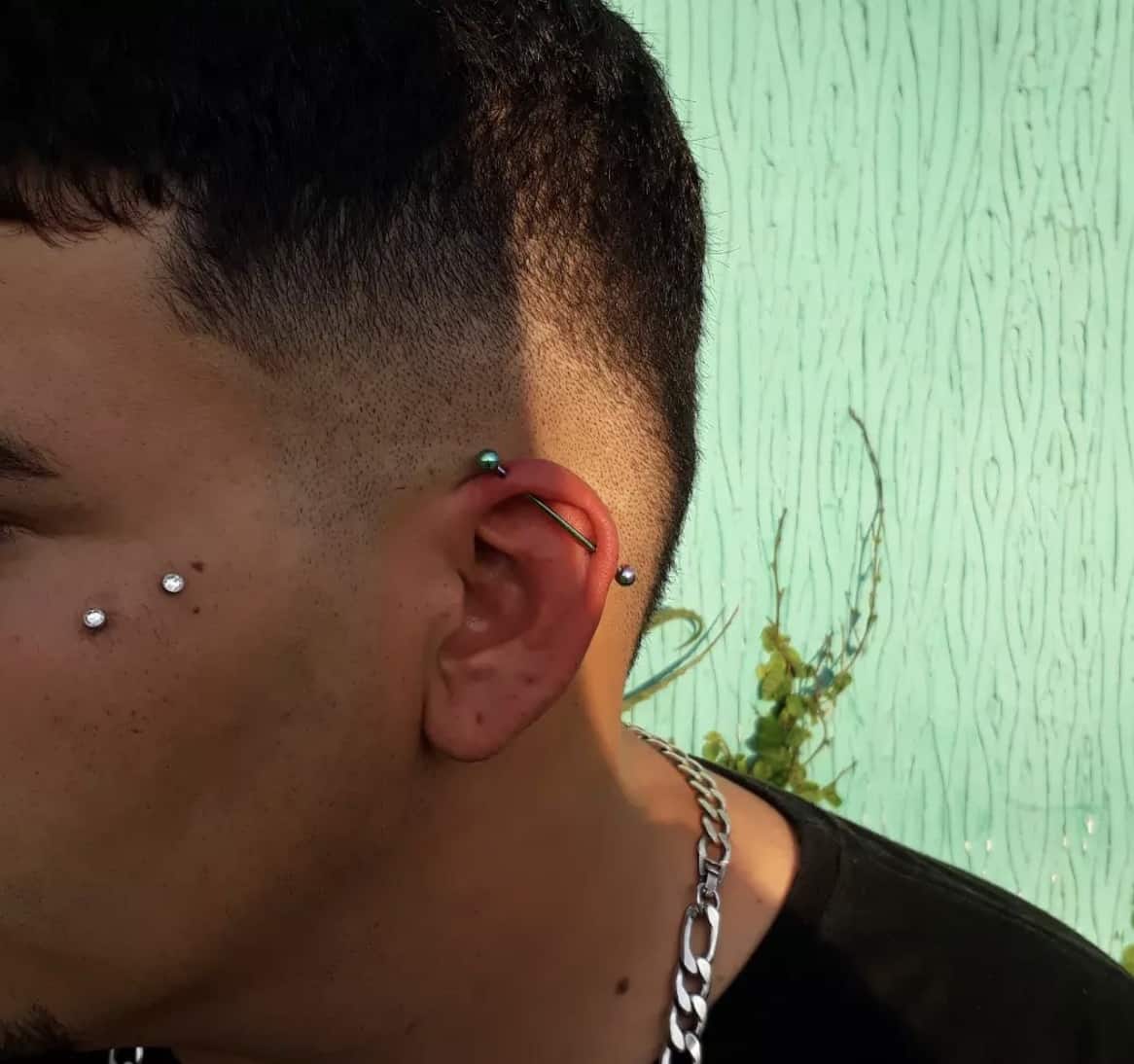
Not for the fainthearted, an industrial is a body modification dating back from the early 90s. It’s essentially a linking earring between two different points on the ear, typically a helix and a forward helix. The single piece of jewelry is called a barbell, or ‘bar’ and should be in solid gold or titanium for optimal ear health.
Unlike simpler men’s ear piercings, an industrial really depends on your ear’s unique anatomy, so make sure you’re working with an experienced piercer before taking the plunge.
Never done with a gun, always a needle, an industrial involves two piercings. That’s something to keep in mind in terms of the healing process. As for time, you’re looking at anywhere from four to six months or up to a year, depending on your body’s immune system.
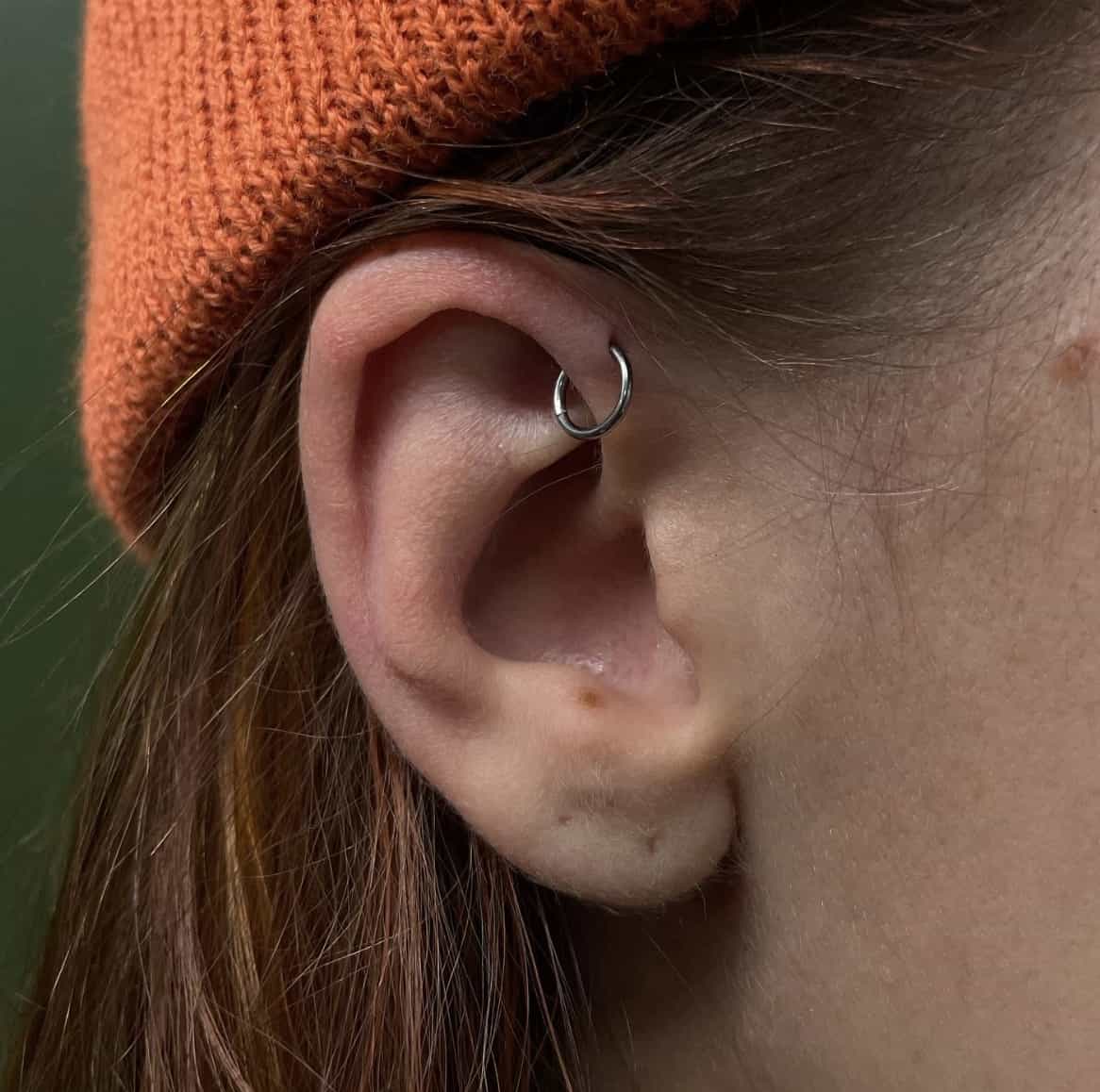
If you’re looking for a slightly unique position for your next ear piercing, try a forward helix. This piercing wraps around the upper cartilage of the ear closer to your temple and directly above the tragus (don’t worry, we’ll get to that).
While a forward helix is fine on its own, it looks awesome alongside other piercings. It’s also customizable with double and even triple helix options. To start, a clean single stud should do.
Because you’re piercing through cartilage, the experience won’t be pain-free, but you are looking at a quicker recovery period than with an industrial. Expect three to nine months.
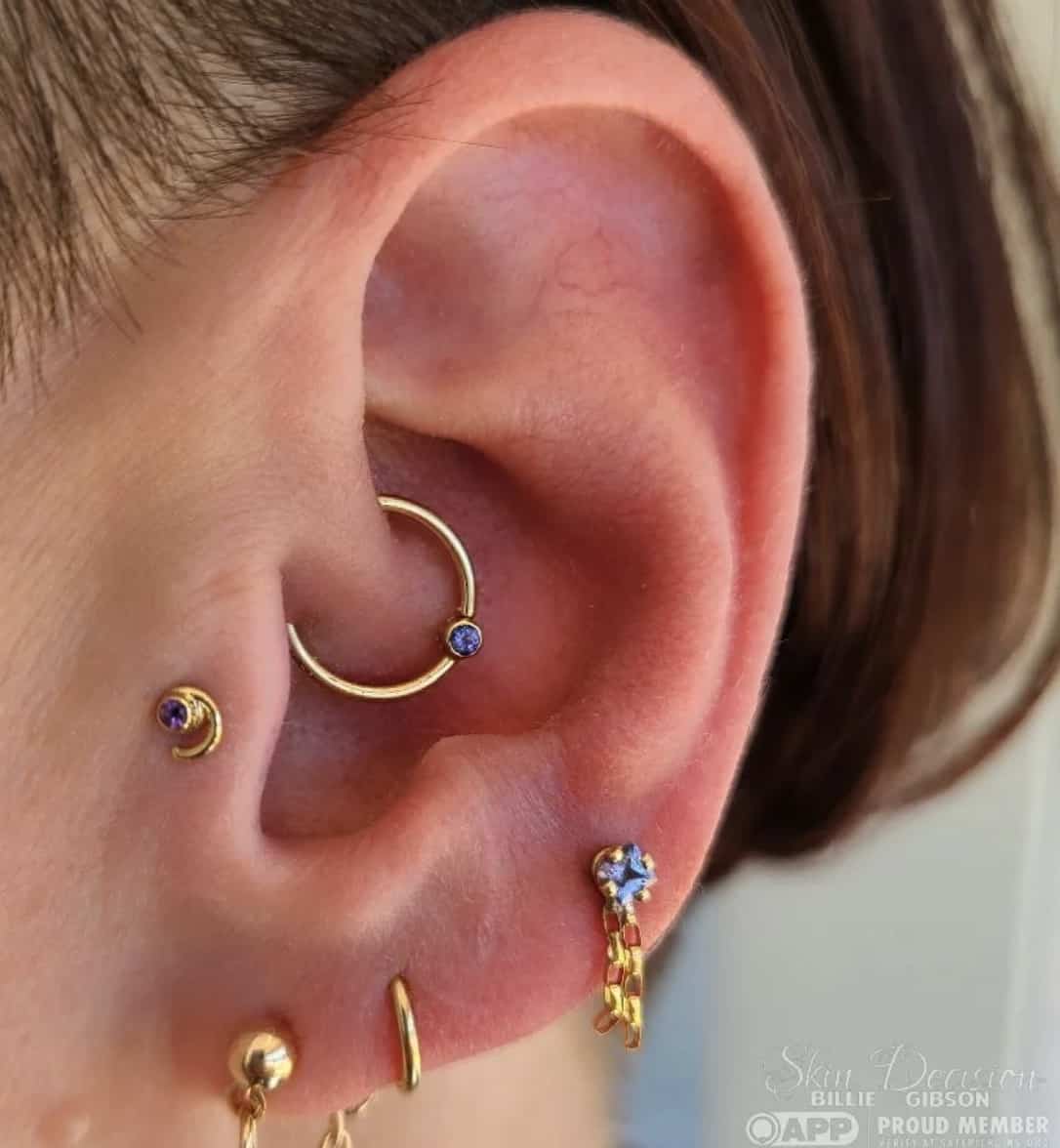
When it comes to multiple piercings, the tragus is an obvious choice. A tragus piercing is a hole in the cartilage over the ear canal. This position looks great on nearly everyone. And in terms of pain, it falls on the lower end of the scale.
Pain aside, a tragus piercing does take about six to twelve months to heal, so be sure you’re ready for the commitment. Because the tragus is a smaller area, a small, fine hoop looks pretty cool, as does a small stud.

Not to be confused with the chess piece, a rook is more unusual than most men’s ear piercings. If you’re looking for a stand-out piercing, this is the way to go. In fact, depending on your ear’s unique anatomy, a rook piercing might not even be possible. This piercing involves puncturing the ridge of cartilage in the upper ear between the inner and outer ear.
Because the cartilage is so thick here, healing takes longer than most other ear piercings. However, it’s a subtle way to add some eye-catching detail. For such a special piercing, try a cool, tiny earring like this solid gold lightning bolt.

An orbital ear piercing is another customizable option for upping your ear game. Similar to an industrial, an orbital links two holes via one piece of jewelry, but instead of a bar, it uses a single hoop.
This piercing can be done either at the cartilage or the lobe. But because the lobe is nice and fatty, it’s going to be way less painful there.
Ask your piercer to write down the exact measurements of both holes so you can buy the proper hoop size later on. Maison Miru designs earrings specifically for orbitals with three different sizing options to choose from.
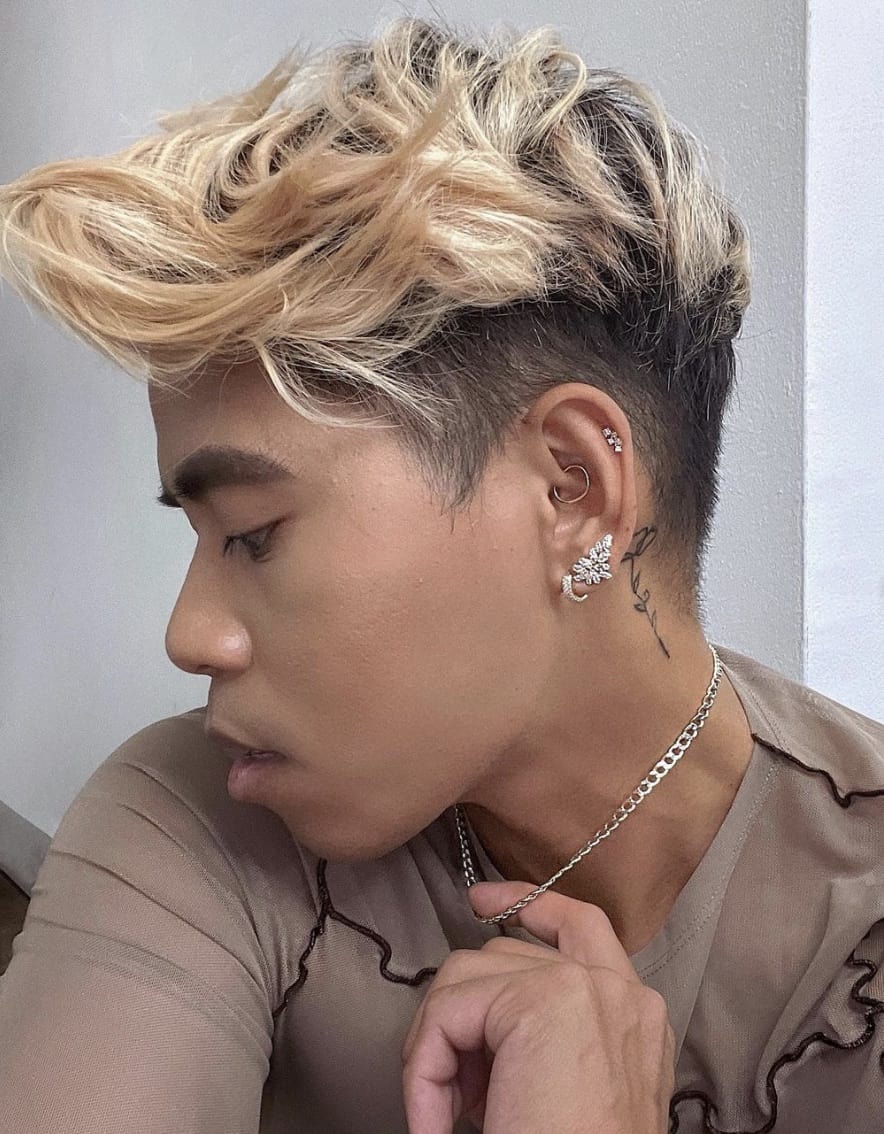
A daith piercing (pronounced like ‘faith’) creates a hole in the inner ear cartilage right next to the tragus. You’ve probably seen people wear a small hoop there that hugs the cartilage. It looks especially cool because it appears at the visual center of the ear.
At the risk of appearing too cluttered on the ear (unless ‘more is more’ is the vibe that you’re going for) a daith looks sleekest when paired with a smooth, un-pierced tragus.
Interestingly, a daith piercing occurs at an acupressure point and has been anecdotally linked to alleviating migraines. That may not be enough to warrant a piercing, but it could be something to consider.
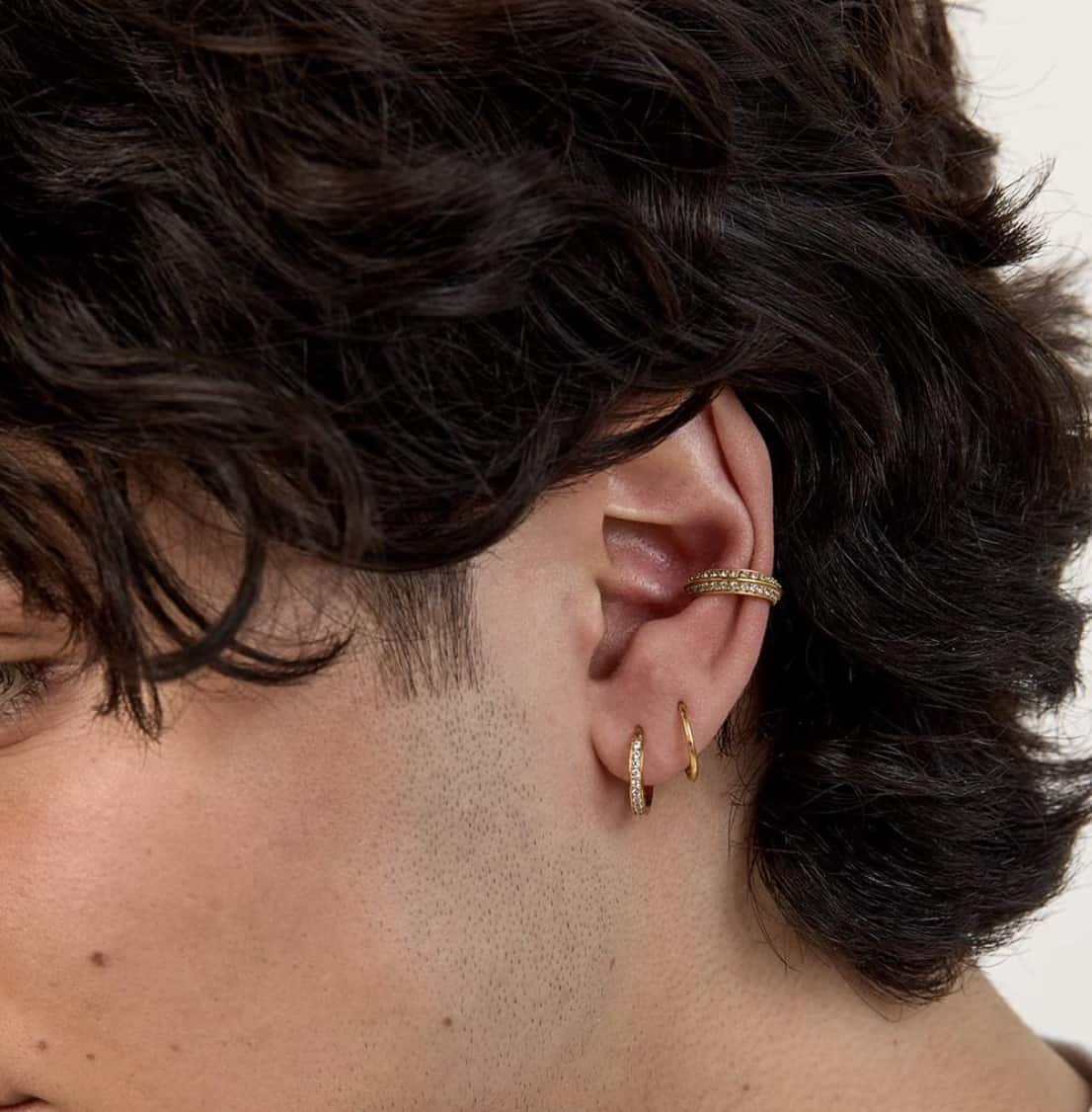
Named after the spiral shape that the ear resembles, a conch piercing takes place in the cup of the ear. This is the ear’s largest area, so customizing a piercing here is easy and gives you more choices to work with.
An inner conch piercing involves a hole punctured in the middle of the ear so only a stud can be worn there. An outer conch is farther out and will allow a hoop to be attached around the outside of the ear.
Because of this variety in placement and the ability to wear a chic cuff around the outside of the ear, a conch piercing is considered one of the most attractive ear piercings for men.

If you can locate your tragus, then finding your anti-tragus is easy enough. This piercing is adjacent to the tragus and creates a hole in the lower portion of your inner ear cartilage. It’s more unusual but looks great with a single regular lobe and a helix.
With an antitragus, things can get crowded, so make sure you’ll have enough room on your ear for another piece of jewelry. Because this part of the cartilage is exceptionally thick (though not quite as thick as the tragus), you’ll likely need a small barbell, hoop ring, or stud to penetrate the skin. We happen to love these tiny diamond studs for a bit of bling.

A snug proves that if there’s any space to puncture, it’s guaranteed to have a special piercing. Also known as an anti-helix, a snug is a puncture on the vertical part of the ear’s inner cartilage. You’ll notice it above the antitragus.
This position is pretty cool as it can be customized depending on the position of your other piercings if you have them. It’s also not very common, so it’s great if you’re looking for something a little different.
Because a snug earring pierces the cartilage, you’ll be able to see both sides of the hole from the front. So you’ll need a small bar or mini hoop earring.

You might hear it called a higher lobe piercing, but its position on the ear is the same. This creates a hole in the upper fleshy part of the earlobe just before the cartilage.
Of course, you can choose an upper lobe piercing without any other lobe piercing, but it does fit right in as part of a full ear game. If you’ve already got your first and second holes on your lobe, try a large, medium, and small flat dot stud that moves up the ear.
It’s easy to have fun with an upper lobe piercing. Like its counterparts, the healing time is a matter of months. And, if your piercer is skilled, the pain isn’t bad, either.
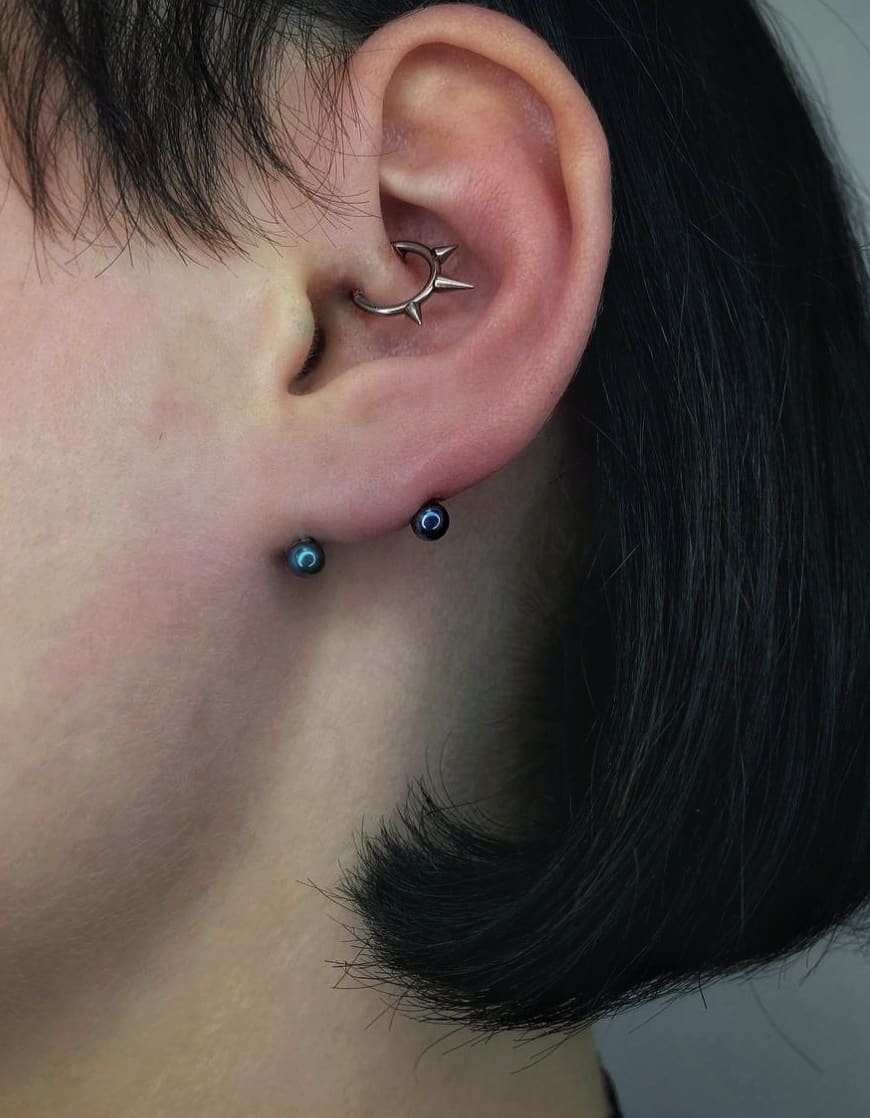
Of all the men’s ear piercings out there, the transverse lobe is probably the rarest. Unlike a traditional lobe piercing that runs from the front of the earlobe to the back, a transverse is a horizontal hole at the bottom of the lobe. Both ends of this side-to-side piercing are visible from the front. For that, you’ll need a solid gold barbell earring to thread through the lobe.
Because it’s done on the lobe, the healing time is rather fast at just over two months. Sounds like a good deal for a piercing that is subtle but still pretty unique.
Final Verdict
For a piercing that’s easy to clean and heals quickly, a lobe piercing is your best bet. A helix and tragus piercing are also popular and look great when paired with other earrings in different positions. Most importantly, men’s ear piercings should be done according to what is comfortable for your ear’s unique anatomy. Once the piercing is done, it’s crucial that you clean and care for it properly.
FAQ
While it certainly isn’t pain-free, an ear piercing should fall between a 3-6 on the pain scale. If your technician is skilled and you’re mentally prepared for the ordeal, it shouldn’t be too painful. Tenderness may persist for a few days but should stop after a week.
When it comes to men’s ear piercings, either side will do, but it is a good idea to pierce the opposite ear of the side you sleep on. There’s no point in suffering for months during the healing process.
With a healing time of just two to three months, a lobe piercing is going to repair itself the fastest. Because cartilage piercings are done in a much thicker part of the ear that receives less blood, healing times are going to be longer, with estimates around four to nine months. At nearly a year, industrials take the longest to heal. Though overall, it depends on the effectiveness of your unique immunity.
Daily cleaning is essential to helping your piercing heal properly. Alternate between a saltwater solution applied 2-4 times per day and a simple cleansing with antibacterial soap twice per day, and don’t forget to twist the stud around in your ear hole. Avoid hydrogen peroxide and alcohol as they will kill healthy new cells and slow the healing process.
Chances are, your hands were dirty when you cleaned or touched your ear. Avoid unnecessary touching as much as possible, change your bed sheets regularly, and try not to press a phone, hat, or sunglasses against the piercing. You may need to increase the number of times you clean the piercing per day but if problems persist, consult a doctor.
While it’s possible to pierce your ear at home, your best bet is to consult a professional. Research your local piercing and tattoo parlors to see if they’re experienced at doing the type of piercing you want. Don’t hesitate to inquire about their sterilization process, so you feel as comfortable as possible.

